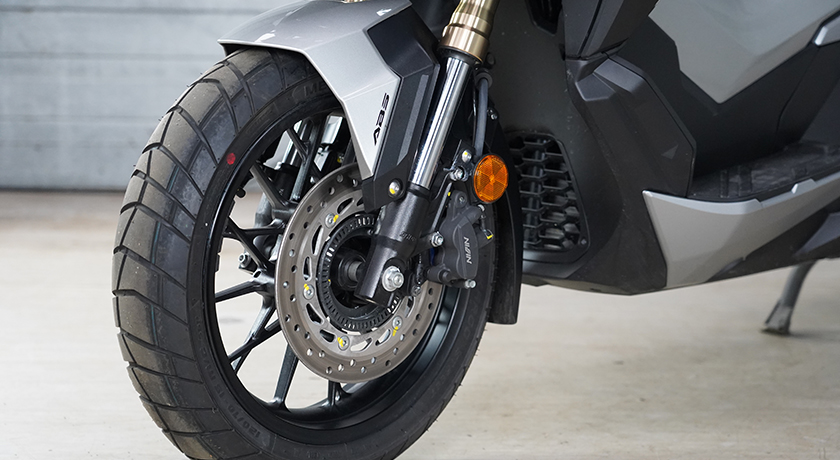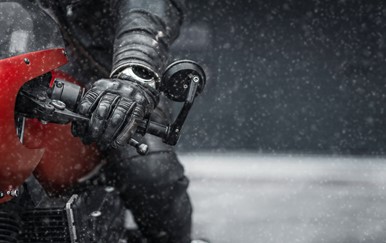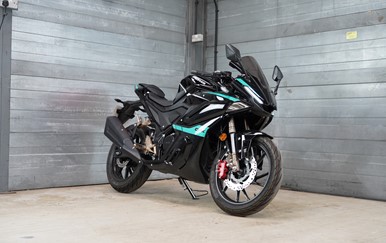Are you planning to ride this winter?
At the time of writing, the weather is getting colder and that can only mean one thing, winter (and Christmas) is fast approaching. You’ll be pleased to know we have compiled a list of some of the best tips we can give you for both preparing and riding your motorcycle this winter.
So without further ado, let’s get into it…
Top 10 Tips to prepare your motorcycle or moped for winter riding

The cold weather can affect your bike in many ways, but that doesn’t mean you should have to haul your bike into hibernation for the colder months. With the help of a little winter motorcycle maintenance, there is no reason why you shouldn’t get to ride.
Before you go anywhere though, you will want to make sure that your motorcycle or moped is appropriately set up and prepared to tackle the winter weather and road conditions…
1. Consider replacing your battery
One element of your bike that will take a beating during the winter months is unfortunately your battery, especially if you are running extras such as heated grips.
If you’ve been having issues with your battery in the run-up to winter, it is advisable you replace it and maintain it through colder months by attaching it to a trickle charger (such as an Optimate) when your bike is not in use.
2. Switch to winter-appropriate tyres

As the tarmac gets colder and wetter, one thing to consider is switching out your summer slick tyres to some winter-suitable ones. For those who live in the UK, we’d recommend you look into some wet weather tyres however, if you live elsewhere outside of the UK you may find that your country by law requires you to invest in some snow and rain-specific tyres.
On the other hand, if you decide not to change your tyres, you will still need to ensure that your main contact patch with the road is in the best condition. Give your tyres a good visual check for tread depth, cuts, bulges, etc and if they’re fine check the tyre pressures.
3. Make sure your fluid levels are topped up
The next thing you’ll want to do is check your fluid levels. If your two-wheeler is liquid-cooled, you will want to check that the antifreeze is ready to battle the upcoming winter elements - even if your bike is stored away for the winter, your cooling system can still freeze!
You will also want to check the oil levels and grease any cables or components that may get attacked by road grime and salt. Moving parts such as brake levers and pedals, switches, and control cables are all susceptible to corrosion.
4. Give your motorcycle a thorough clean
As temperatures drop, councils and agencies set out on a mission to grit the roads as often as possible in an attempt to stop them freezing over. This will not only accelerate the corrosion of the cosmetic parts of your bike but also play havoc with some of the controls too.
The general rule of thumb is to clean your bike more often in the winter, as this not only removes the potentially corrosive grit and salt but will also give you the opportunity to examine the various parts of your bike and take any preventive measures necessary. You will also find your lights get dirtier far more quickly in winter months, so make sure they get a good scrub before heading out as well.
5. Clean and lube the chain regularly

Again, this is another task you can carry out whilst cleaning your bike and can really help to extend both the life and performance of your two-wheeler. If you don’t already have an automatic motorcycle chain oiler fitted, you must lube your chain weekly.
Getting your bike on a paddock stand will help the rear wheel and chain run freely while you apply making sure you only lubricate after riding your motorcycle instead of beforehand - letting it dry overnight for the best effectiveness.
6. Apply corrosion protectants
If you have an older scooter or bike you might want to consider using an anti-corrosion/lubricant compound such as ACF-50 to protect the metalwork. It is an ultra-thin fluid film compound which I’ve used for a while now and it is safe to say that I am very impressed with the results so far.
7. Fit a windscreen
Another thing you should consider when preparing your motorcycle for winter is considering fitting a windscreen. Whilst they’re not always the coolest thing in terms of style, the right screen can really make riding far more comfortable once the winter takes a turn.
8. Consider fitting extra storage space

As we move into winter, it is well worth packing yourself an extra set of waterproofs and some spare gloves just in case you need them. When packing more in your motorcycle for your daily commute, it will mean that you need more storage room.
If you don’t already have enough underseat storage on your motorcycle to fit these items, we’d recommend fitting a topbox to fit all of your winter riding essentials in one place. After all, nobody wants to be stranded at the side of the road when the temperature drops below zero, right?
9. Adjust the suspension
One of the final tips to give you when it comes to preparing your motorcycle for winter is to adjust your suspension. A firm suspension setup will reduce your grip on the roads in slippery conditions, so it is most definitely worth softening up your suspension to help you feel the road grip far closer.
10. Invest in some heated gloves or heated handlebar grips

Arguably one of the best investments you will ever make for winter riding is by purchasing some heated motorcycle handlebar grips or heated motorcycle gloves.
As mentioned in our must-have accessories for beginner motorcyclists blog, heated handlebar grips and gloves are more than just a comfortable feature to keep you warm, they also act as a safety feature as well, keeping you in complete control of your bike.
Top 10 tips for riding your motorcycle in the winter

Staying safe on the roads in winter takes more than just bike maintenance. It is also important to take extra care when riding in wet and icy conditions.
Collectively, the team here at BikeMatters has many years of riding experience in their back pocket and know a thing or two about riding during the colder months. So with that being said, here are their top winter motorcycling tips…
1. Be confident, not fearful
Being fearful of wet and icy roads is one of the most common mistakes a rider can make. If you treat the wet with respect, ride smoothly, take a straighter line through the corners, and use less lean angle than you would in the dry - you’ll be good to go.
2. Consider advanced training courses

Another great way to build up your confidence when riding is to sign yourself up for some advanced training courses. There are plenty across the UK and can really help to transform your winter riding skills and enjoyment on two wheels.
Another bonus is that some advanced riding training courses can in fact help you save a bit of money when it comes to insuring your motorcycle or scooter (so overall it is a win-win)!
3. Keep an eye on the road surface
Make sure to stay alert and try to avoid riding over any manhole covers, painted road markings and potholes. Applying the accelerator and brakes smoothly is arguably one of the most important parts of wet riding.
Remember when it is wet or icy, even the wet leaves can be detrimental to your riding experience!
4. Stay alert and wear high-visibility gear
Having a good level of visibility and working lights are paramount when riding a motorcycle through the winter months. However, this also applies to you as a rider as well and it is in best practice for you to wear high-visibility gear if you want to be seen by other road users.
You should never just assume that people have seen you or that they are keeping an eye out for you. Make sure to treat every user of the road with caution and stay alert.
5. Layer up appropriately

Alongside wearing hi-vis gear during the winter, it is well worth your time to invest in a heated motorcycle jacket or vest, heated gloves or grips, as well as some thermal underwear.
Keeping warm and dry while riding not only makes your journey more pleasant, but it will also make you a safer rider. Once we get cold our concentration levels drop, as well as our reaction times become slower - all of these factors can put you at higher risk of being involved in a collision.
6. Keep your distance from other road users
Following on from number three, you should always remember to approach other riders with caution, hanging back when you need to and being patient. Whilst you might be paying attention to your surroundings, other road users may not, and trying to overtake especially in icy or wet conditions can threaten your safety.
7. Consider increasing your braking distance

You should also remember to brake and signal far earlier during the winter months. Braking distances can be up to 10 times longer in winter in comparison to a typical during the summer. Not only should you allow increased braking distance, but you should also allow additional time for braking gently to help you avoid skidding.
8. Make sure you have the appropriate breakdown coverage
If your motorbike breaks down or you are involved in a collision during your commute, the last thing you will want is to be stuck at the side of the road in the freezing cold.
Breakdown coverage is an entirely optional add-on to your insurance policy, however, if you are in need and looking for cover make sure to check out Lexham!
9. Check the weather before leaving the house
Before you even consider getting on your bike for the day, always check the weather. In the event that conditions are particularly bad, for example when the roads are covered in snow, genuinely have a think about whether you should ride.
You should be honest with yourself too, and think hard about how comfortable you’ll be and how difficult it will be to ride in the conditions you see. Don’t rely solely on a weather report or app to inform your decision, look out of your window too.
10. Ask yourself: Do I really need to go out?

Take some time to think about how other road users and drivers might behave. Is your journey really that important? Is there another way to get to work? Your boss would rather have you at work a few minutes late, rather than a few months late after a spell in hospital.
As much as we love getting out on two wheels, some days it’s not worth it. If you have the option, on these days it’s better to leave the two-wheels at home and take a different mode of transport.
If you find yourself unsure, follow our handy dos and don’ts of winter riding below:
| Dos: | Don'ts: |
| Brake and signal earlier to account for wet roads | Don't ride in strong winds, or try to avoid it |
| Check the weather before heading out | Don't wear dark clothing |
| Slow down and allow more time for your journey | Slow down and allow more time for your journey Don't ride if it's snowing where possible |
| Wear warm, reflective gear | Wear warm, reflective gear Don't underestimate wet, icy roads |
| Use an anti-misting spray on your visor | Use an anti-misting spray on your visor Don't use the same lean angles as usual |
Winter Motorcycle Riding FAQs:

Can you ride a motorbike during Winter in the UK?
The answer is yes. You are perfectly fine to ride in winter, providing that you take the correct precautions before you ride to keep both you and your motorcycle safe on the roads.
How cold is considered too cold to ride?
Any temperatures below 10°C can and will affect your riding abilities if you are not wearing the appropriate gear. Whilst you can ride in these conditions, it is entirely up to each individual rider and their confidence as to whether they feel comfortable to hop on their bike and ride.
However, once the temperature goes below 0°C, also known as the freezing point, it is advisable that you leave the bike at home as snowy and icy conditions on icy roads can be extremely difficult to ride on and can put both you and your motorbike in danger.
During the winter months, it is definitely worth keeping your eye on the weather forecasts before you commute to work in the mornings just so you have an idea of the weather you’ll be facing that day. We know (thanks to the UKs extremely unpredictable weather pattern) that the weather can change in an instant, so it is always worth staying prepared for every type of weather condition just in case!
Is riding in the snow a no-go?

Riding your motorcycle in the snow is more than doable, providing that you feel confident enough in yourself to do so.
Surprisingly, fresh snow can be ridden on fairly easily (providing you can see where the road ends and the pavements start) as it compacts under your tyres, making it far less slippery than snow that has already been ridden or driven on.
On the other hand, riding on pre-existing compacted snow can be extremely difficult to ride on due to its extremely slippery nature (as we mentioned above), as well as running the risk of coming across black ice.
If you are planning to venture out on your motorcycle in the snow, it is advised that you stay close to the centre of the road that should have the freshest snow, making sure you take care when riding over pre-existing tyre tracks on pieces of road such as roundabouts and junctions.
Is it safe to ride in windy conditions?
Again, much like the weather conditions we've touched on previously, whilst riding in the wind can be scary, it is more than doable providing you have the confidence.
As expected, with wind comes added caution so it is essential that you make sure your bike is compatible with riding in the wind. Typically, bikes with fuller fairings or tall windscreens have a much larger surface area which can be blown about by winds making them harder to control.
Once you’ve checked your motorcycle is ready to tackle the windy conditions, when riding you will need to stay alert for any debris that may come your way whilst riding such as branches, wheelie bins or chimney pots.
It is also worth noting that if you’re approaching an area where you know you’re likely to be caught with stronger guts of wind, it is advisable that you use the larger machinery on the roads such as a lorry to shield yourself - however, just make sure you leave them plenty of room while doing so!
The Last Stop!
So there you have it, I hope you enjoyed my rundown on just some of the best pieces of advice we can give you when it comes to preparing your motorbike and riding for winter.
Last but not least, another great way of preparing your bike for winter that we haven’t mentioned yet is by having appropriate insurance coverage. If you do have your very own motorcycle you need to insure, make sure to get a motorcycle insurance quotation direct with Lexham!










